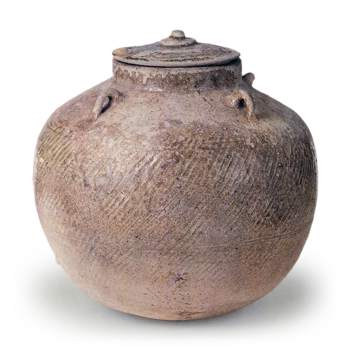
Excavated from a tumulus at Tōshi-machi, Toba-shi, Mie.
7th century.
Total height 20.7cm, mouth diameter 9.2cm, body diameter 20.8cm
Aichi Prefectural Ceramic Museum
Large short-necked jars with four circular ears on the shoulders were often used as cremation urns in ancient times. This vessel was reportedly excavated from a burial mound, and it is not clear whether it was used as a cremation urn or not. The spherical shape of the body and the lack of a base suggest that it was made in the late 7th century. The lid also has a gable that is fitted into the oral cavity, and the shape of the two-tiered cord indicates that it was made in an earlier stage than the later Shosoin medicine jar type that had a covered lid. The clay cord is rolled up and pounded into shape, and double chinkansen lines are applied to the shoulders and body. The ring-shaped ears are also unique to this period, made of thin clay cords with circular cross-sections attached to them. The base is nearly white and is well tempered, with a light brownish-green natural glaze on the upper surface of the lid and the upper half of the bust.



